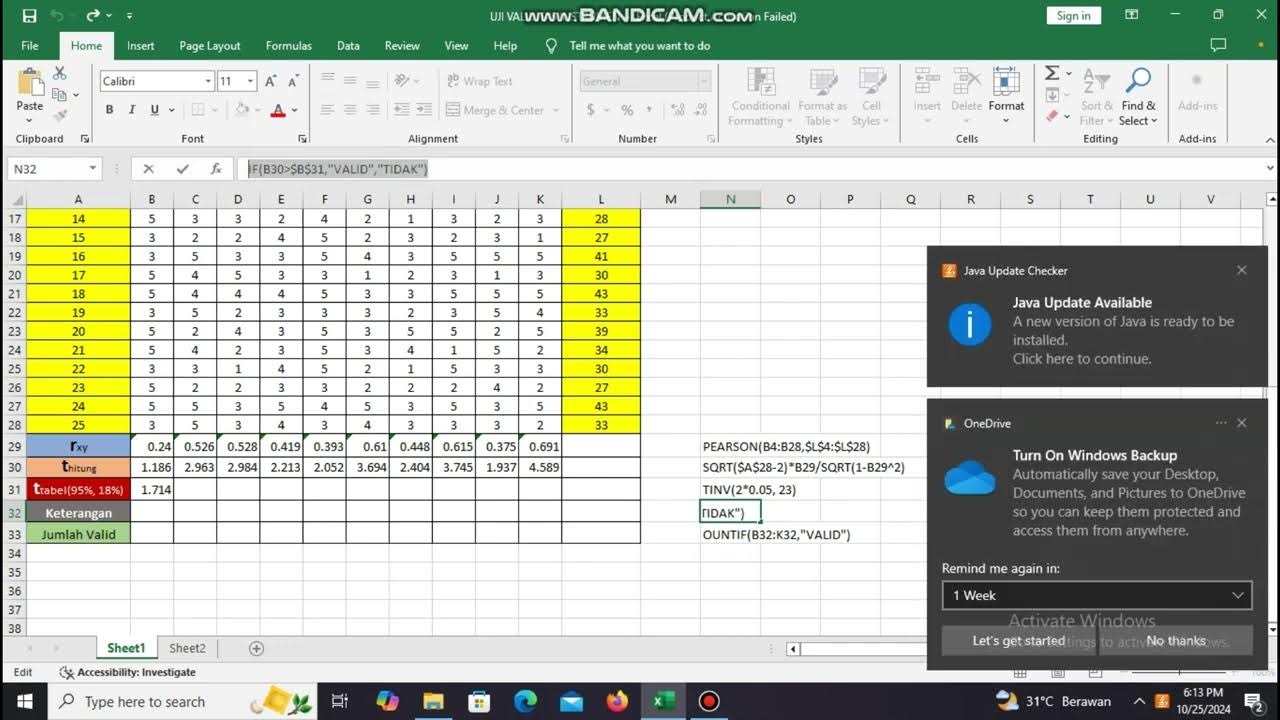TUTORIAL SMARTPLS : UJI VALIDITAS DAN RELIABILITAS SMARTPLS
Summary
TLDRIn this video tutorial, the process of conducting validity and reliability tests using the Smart PLS program is explained. The speaker breaks down key concepts like convergent and discriminant validity, as well as reliability tests using Cronbach's Alpha and Composite Reliability. A practical example is provided, demonstrating how to set up the model, import data, and run the necessary calculations. The tutorial emphasizes how Smart PLS helps researchers interpret results through color-coded indicators, ensuring accurate and consistent measurement of constructs in research.
Takeaways
- 😀 Validity and reliability tests are critical to ensure accurate and consistent measurement in research data.
- 😀 Validity tests confirm if a questionnaire measures what it's supposed to measure, while reliability tests ensure the consistency and accuracy of the instrument.
- 😀 In Smart PLS, the validity test consists of two parts: convergent validity and discriminant validity.
- 😀 Convergent validity is checked using loading factors (should be greater than 0.70) and Average Variance Extracted (AVE) values (should be greater than 0.50).
- 😀 Discriminant validity is tested with the HTMT value, which should be less than 0.90 to ensure distinct constructs are being measured.
- 😀 Reliability is assessed using two methods: Cronbach’s Alpha and Composite Reliability, with values above 0.70 considered acceptable.
- 😀 In Smart PLS, the software gives a visual indication of test results with green (good) and red (bad) color coding.
- 😀 The steps in Smart PLS for conducting these tests include importing data, setting up a model, and running calculations.
- 😀 When conducting the tests, it's important to interpret results such as loading factors, AVE, and Cronbach's Alpha to confirm validity and reliability criteria.
- 😀 A successful validity and reliability test ensures that research data is trustworthy and can be confidently used for further analysis.
Q & A
What is the purpose of validity and reliability tests in the Smart PLS program?
-The purpose of validity and reliability tests in the Smart PLS program is to evaluate the effectiveness and consistency of the measurement instruments used in research, ensuring that the data collected is both valid (accurate) and reliable (consistent).
What is the difference between validity and reliability tests in the context of Smart PLS?
-Validity tests measure the accuracy and appropriateness of the data collection instruments (such as questionnaires), while reliability tests assess the consistency and precision of these instruments in measuring a construct across multiple instances.
What are the two types of validity tests used in Smart PLS?
-The two types of validity tests used in Smart PLS are Convergent Validity and Discriminant Validity.
What criteria are used to assess Convergent Validity in Smart PLS?
-Convergent Validity in Smart PLS is assessed using two criteria: the Loading Factor (which should be greater than 0.70) and the Average Variance Extracted (AVE) value (which should be greater than 0.50).
How is Discriminant Validity evaluated in Smart PLS?
-Discriminant Validity in Smart PLS is evaluated using the HTMT (Heterotrait-Monotrait) ratio, where the value should be less than 0.90 to confirm that the assumption of discriminant validity has been met.
What are the two methods used to assess reliability in Smart PLS?
-The two methods used to assess reliability in Smart PLS are Cronbach's Alpha and Composite Reliability.
What is the required threshold for Cronbach's Alpha and Composite Reliability in Smart PLS?
-Both Cronbach's Alpha and Composite Reliability must have values greater than 0.70 to meet the reliability assumptions in Smart PLS.
How does Smart PLS help users interpret the validity and reliability test results?
-Smart PLS uses color coding to help users interpret the results. Green indicates a good result, while red signals an issue or failure to meet the criteria.
What steps are involved in setting up a model for validity and reliability testing in Smart PLS?
-To set up a model for validity and reliability testing in Smart PLS, users need to import the data, create a new project, assign the variables to their respective items, and then run the calculation using the PLS Algorithm.
What should users look for when checking the Loading Factor during the validity test in Smart PLS?
-Users should ensure that the Loading Factor values for each item are greater than 0.70. This indicates that the items have sufficient convergent validity.
Outlines

This section is available to paid users only. Please upgrade to access this part.
Upgrade NowMindmap

This section is available to paid users only. Please upgrade to access this part.
Upgrade NowKeywords

This section is available to paid users only. Please upgrade to access this part.
Upgrade NowHighlights

This section is available to paid users only. Please upgrade to access this part.
Upgrade NowTranscripts

This section is available to paid users only. Please upgrade to access this part.
Upgrade NowBrowse More Related Video

TUTORIAL SEM PLS: METODE ANALISIS DATA

STATISTICS BASED ON SMARTPLS - ENGLISH FOR GENERAL PURPOSE (ANGELA VICTORIA - 2414190037)

Cara Uji Validitas Pearson Product Moment dan Uji Reliabilitas Cronbach Alpha Dengan SPSS Lengkap

Uji Validitas dan Reliabilitas dengan EXCEL - Uji Validitas Pearson Correlation

Penilian Kapabilitas, Uji Validitas dan Uji Reabilitas Cronbach Alpha di MS Excel

Cara Uji Validitas dan Reliabilitas dengan SPSS FULL
5.0 / 5 (0 votes)